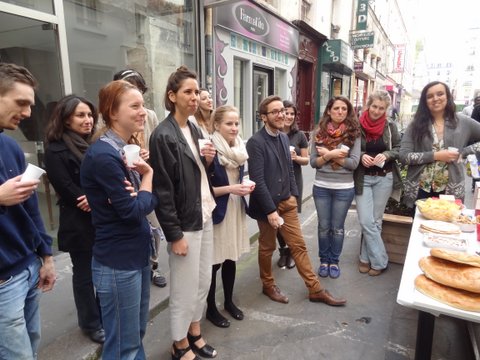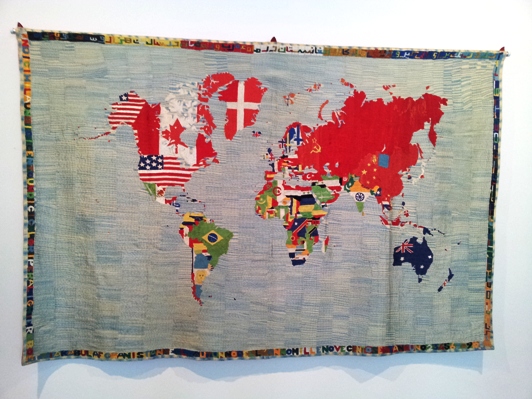Over the past years, most of my visits to contemporary art exhibitions have ended in disappointment. I consider myself an ex-curator: after my last show in 2015 I decided to step out of the art world. I usually tell people I enjoyed working with artists but increasingly disliked the art world, in both its commercial and institutional aspects. But this Biennale has left me inspired and hopeful for the art world – reviving my old hope that artists give creative expression to the deep undercurrents of collective development, giving an indication of where we are heading. This impression was left especially by “The Milk of Dreams” show curated by Cecilia Alemani, but surprisingly also by many of the national pavilions and some of the collateral events.
Continue readingCategory Archives: Exhibition review
Review of Crisis of History in Belgian art magazine
Aya Johanna Danielle Durst Britt wrote a thoughtful review, in Flemish, of the exhibition in Amsterdam I curated – and which recently finished – in Al Arte Magazine.
Making an exhibition with my students at the Paris School of International Affairs
This year (2014) I asked my students to write their papers as catalogue contributions to an exhibition I made in Paris to coincide with the end of the term.
Here one can find the links to their papers and images of the exhibition, which I made with the help of the Window, an art space in the center of Paris run by a good friend of mine and those that contributed to the crowd funding project I ran – especially my father!
Ibrahim Abumsmar at the Window in Paris
I curated this small exhibition (27-29 September 2013), whose only ambition was to document the two months residency of Ibrahim Abumsmar in Paris – whence the simple title, ‘A Saudi Artist in Paris’. It turned out quite nice.
Below are the wall texts (in French) interspersed with some photographs. More information including links to The Window, the artist and his gallery (Athr) can be found on the previous post ‘A Saudi Artist in Paris‘. Continue reading
China China

Wang Qingsong was not the most controversial artist of Transfiguration, the official Chinese Pavilion. This giant photograph ‘Follow Him’ (2010) is apparently a critique on the accumulation of knowledge culture we live in.
Shortly after checking into the hotel, I went for a ‘short stroll’. Being back in Venice gave me a natural high, so I wandered further and further from the hotel, until I came to the metal gangway that hangs from the endless walls of a fort-like structure over the lagoon. I was just thinking “I really ought to go back” when I chanced upon an open door in the wall, leading to the giant exhibition ‘Voices of the Unseen, Chinese Independent Art’.
The installation of the exhibition was far from complete, many artworks still being half-wrapped. I wandered through hangar after hangar filled by what seemed at least a hundred Chinese artists. With one or two exceptions I found most of the art garish, commercial, unsurprising – confirming my bias of Chinese art. Seeing that the exhibition had been organized by the Guangdong Museum of Art I also wondered what ‘independent art’ might mean. It seemed to refer to ‘marketable art’.
The same team is behind the über-cool Guangzhou Triennial (the last two editions were called “Meta-Question: Back to the Museum Per Se” and “Farewell to Post-Colonialism”). It is all very depressing.
How big my surprise then when, the following day, I reluctantly visited the official Chinese Pavilion and discovered much more experimental and critical art – truly captivating. As if the Communist Party of China were still truly involved in the problems of society and self-criticism (jiantao) but has given up the illusion of progress under its reign – while the liberal bourgeoisie and capitalist class is celebrating its ascendancy with art that seems to deride any ideal with irony, even sarcasm.
This reversal of positions was truly perplexing, but alerted me to the danger of approaching the perils of ‘national representation’ too simplistically.
Quote from the Ideological Guide: The China Pavilion thus stakes a claim against the commodifying of dissent (…) Is it possible to give this nuance and subtlety a more permanent presence within the onslaught of the marketplace?
More reading: interesting background info on Global Times China
An Encyclopedia of National Representation: Review of the Venice Biennale, 2013

Alfredo Jaar’s iconic installation of the Giardini rising from the bottom of a pool only to disappear again quickly under the waves. Photo & composition by RK
Although I came to Venice to test and explore an artist’s project that fundamentally critiques the system of national representation at the Biennale, I must admit I enjoyed the national pavilions much more than the group show “The Encyclopedic Palace” and some of the collateral events.
Artists and curators asked to represent their country invariably grapple with the question how to ‘represent the nation’ and why they should be the ones called to do it. This intellectual quandary produces some interesting artistic results. Besides, this system does allow for a plurality of approaches to be present in the same event, notably empowering voices from the periphery.
I had my hands full with checking the national pavilions around town and relating what I saw to Jonas Staal’s Ideological Guide to the Venice Biennale. This guide, an app for android and apple-ware, describes each pavilion in detail, providing statistical data for the country, its conflicts and alliances, with a cover piece by an art professional well acquainted with that country, usually a ‘national’ (sic).
It has a navigation system, and although I usually spurn such devices, preferring to rely on my sense of orientation, knowledge of the city map and passers-by, I did use this one. Venice is a labyrinth. The precise GPS pinpointing is more useful than the Biennale’s map. So I managed to see quite a lot in two days, while maintaining the time for long exchanges with the artists and an occasional curator.
What follows are reflections about the national pavilions, interspersed with comments about the Biennale in general and personal perspectives on artists and shows that were not part of the national representation mechanism.
I will be adding the chapters on the national representations as I finish writing them.
All the Middle Eastern national presentations
Afghanistan in Documenta 13
Note: a very different, one-page graphic version of this article was published in the Belgian art magazine A Prior #23; see the article here. I published another article about this subject in the Indian art magazine Take On Art.
With fourteen Afghan artists and at least ten artists whose work reflects on this country, Documenta 13 is strongly flavored by Afghanistan. After Kassel, Kabul is the main location of Documenta (the others being Alexandria & Cairo, and Banff in Canada): 27 Documenta artists will show their work in the Queen’s Palace in Kabul’s Babur Gardens in an exhibition that opens on June 20. Continue reading
A visit to the National Museum of Riyadh
The National Museum of Riyadh is a very interesting museum designed by the Canadian architect Raymond Moriyama (figs 1 & 2). It was inaugurated in 1999. It is located on the grounds of the Murabba Palace that was built by King Abdul Aziz in 1936/37 north of what was then Riyadh, a small and congested walled city. Many of the buildings of this palatial complex that fell into disuse in the early 1950s have been beautifully restored, and together with the gardens that surround them they form one of the only large public spaces in Riyadh (figs 3 & 4). Many people come here to stroll, picnic and watch other passers-by. Continue reading
Exhibition of Mahmoud Dayoub in The Hague
I recently set up an exhibition in the headquarters of the Humanistic Institute for Development Cooperation (Hivos) in The Hague. The works are by the young Syrian artist Mahmoud Dayoub. Hivos headquarters are situated on the Raamweg 16 in The Hague and the exhibition can be seen every weekday during office hours (8am to 6pm) until 7 December 2011.
De Gele Koe als startpunt voor Saoedische kunst
NRC nieuw orientalisme 14 April 2011
Goed artikel van Raymond van den Boogaard waarin ik en mijn medereizigers worden geinterviewed over hedendaagse kunst in het Midden-Oosten.






